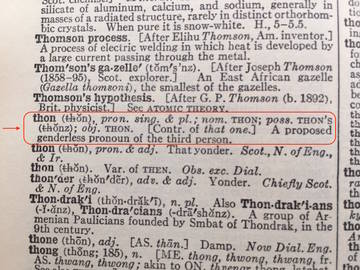One of the most common complaints that one hears about the English language is that it lacks a gender-neutral pronoun for referring to a single third person. The fact that this lack of a word is entirely imaginary (we do have words for this) has not stopped a number of people from proposing solutions to the problem.

'Thon', short for "that one," appeared in our Unabridged dictionary from 1934-1961. Though the word was dropped for lack of use, other gender-neutral pronouns—'they', 'their', and 'them'—remain.
In her Master’s thesis from 1991 (Solving the Great Pronoun Problem), Kelly Ann Sippell provided an extensive list of gender-neutral third-person singular pronouns that had been proposed over the previous hundred and fifty years. This list included, but was not limited to, hes, hiser, hem, ons, e, heer, he’er, hesh, se, heesh, herim, co, tey, per, na, en, herm, em, hir, and shey. Sippell estimated that there had been approximately 80 suggested ways of saying "him or her" or "his or hers" in a single word that was not they or theirs. For those who are interested in a spectacularly comprehensive list of gender-neutral pronouns which never quite caught on readers may turn to Dennis Baron’s magisterial treatment of the subject in American Speech in 1981 (“The Epicene Pronoun: The Word That Failed”), in which he documents over 100 proposed lexical items, dating in use back to the middle of the 19th century (nim, talis, iro and ver are some of his findings).
The one thing that unites almost every one of these solutions to the problem of our language’s seeming lack of an epicene third-person pronoun is that they have all failed to catch on. Note that the previous sentence used the phrase ‘almost every one,’ since there has been one proposed gender-neutral third-person pronoun which almost made it into the general vernacular. That word is thon.
Thon is thought to be a contracted form of "that one," and was coined in 1858 by Charles Crozat Converse. An attorney and composer, Converse invented more than words; he submitted a claim in 1863 to Scientific American that he had designed a new sort of mangle (“a machine for ironing laundry by passing it between heated rollers”). Converse is remembered more these days for his linguistic contributions than for his laundering ones.
The initial reason that thon caught on was that one or more of the editors at Funk and Wagnalls took a shine to the word, and around the turn of the 19th and 20th century it was included in their dictionary.
thon. Pronoun of the 3rd person, common gender, meaning “that one, he she, or it”: a neoterism proposed by Charles Crozat Converse, and apparently complying with the neoteristic canons, since it supplies an antecedent blank, obeys a simple and obvious analogy, and is euphonious.
—Funk and Wagnalls, Supplement to A Standard Dictionary of the English Language, 1903
The word remained in various Funk and Wagnalls publications for much of the 20th century, and also saw inclusion in another dictionary, Merriam-Webster’s Second New International Dictionary (1934), although it was defined slightly less fulsomely (“A proposed genderless pronoun of the third person”). The genderless pronoun sense of thon did not last as long in Merriam-Webster’s dictionaries as it had in Funk and Wagnalls, and the entry was dropped for the third edition of our Unabridged dictionary, published in 1961.
People really wanted thon to work out; the word was used in crossword puzzles for several decades, generally as the answer to the clue of “proposed genderless pronoun.” It was poked at and analyzed by linguists. The cartoonist Ryan North even devoted one of his marvelous Dinosaur Comics strips to the topic of thon. There is a considerable body of evidence of the word in print, for it seemed that whenever a newspaper columnist wrote an article bemoaning our language’s lack of a gender-neutral third-person pronoun, several people would write letters to remind the paper that thon had been coined back in 1858.
There may be a considerable amount of evidence of the word in print, but there is not a great amount of it in actual use, which is why thon has been dropped from the few dictionaries in which it was included. The fact that thon failed despite so many people rooting for it to succeed serves as an illustration of how difficult it can be to make a word enter the language.
"So!" many of you are doubtless wondering right now, "now that you have cruelly taken thon from us, Merriam-Webster, what do you offer as replacement? Sie? Heesh? Herm? Or do you only offer the despondency for what might have been?"
We may define despondency, but that is not what we offer as a replacement for thon. If you find that you have need of a third-person gender-neutral pronoun, why don’t you try using the words that we describe as “well established in speech and writing, even in literary and formal contexts.” These words are familiar to us all: they, their, and them.
Here is what our usage experts wrote on the the subject more than 20 years ago:
We must remember that the English pronoun system is not fixed. Several centuries ago the objective plural you drove the nominative and objective singulars thou and thee and the nominative plural ye out of general use. It appears to have happened for social reasons, not linguistic reasons. They, their, them have been used continuously for six centuries, and have been disparaged in such use for about two centuries.
—Merriam-Webster’s Dictionary of English Usage, 1994




